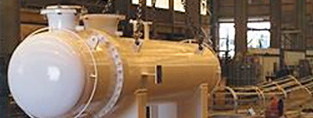
- (03) 5909 8218
- enquiry@fusionweld.com.au
What Are Air Receiver Vessels?
August 7, 2015

Classed as an integral part of any air compression system, air receiver vessels act as reservoirs or storage vessels within air-powered systems. Applications for the apparatus abound throughout commercial venues and industrial facilities. Any hardware store worth its salt will have an aisle dedicated to the equipment, allowing curious engineers to size and grade the vessel for domestic tasks. On ramping up the scope of the equipment, industrial-grade air receivers are manufactured as high calibre products, container that can safely store air as compressed by a prime mover. Secondary design factors position the air receiving vessel as a buffer within a complex network of pipes, valves, filters and separator stages.
Air Compression Applications
As concisely stated, a receiver vessel stores pressurized air and uses the container as a buffer, but these undefined facts could benefit from some fine detail. Firstly, let's define an area where industrial air compression is used. Pneumatic control systems, control and instrumentation frameworks that adopt spark-free operability, are preferred within hazardous environments. These systems utilize narrow tubes to deliver precise control to distant actuators. They also add supplemental ports within the system, interfaces where air-powered tools can plug in when work needs to be done. In fact, pneumatic signals are the preferred power source within many hazardous industrial settings. In these perilous locations, electrical circuitry is left safely ensconced behind reinforced control cabinetry while pressurized air manages valve opening operations and other control elements.
Designing Air Receiver Vessels
Having defined the usability factor that governs air compressor implementation, the design specifications of an air receiver vessel have to account for enough storage capacity to power remote pneumatic valves and air-powered tools. Those oil and gas refinery controls need a reliable control interface, a feat of engineering that can't be achieved unless the vessel is fabricated to partner with the compressor and the associated air conduits. The receiver can be mounted horizontally or vertically, but it must be sized to match the air compressor's operational characteristics. Additionally, the size of the installation, the equipment, type of valves, and all supplementary pneumatic equipment will affect the load characteristics of the vessel. Typical horizontal models adopt a low capacity profile, somewhere in the 25 to 325 litre range. Meanwhile, towering vertical containers can store substantially more air, holding between 100 and 1000 liters at a maximum work pressure of 1100 kPa.
A great deal of effort goes into the production of industrial air compressors, designs that incorporate reciprocating mechanisms or rotary screw constructs. Design calculations for the integral air receiving vessel are just as exacting. The designs are welded and fired to withstand extreme pressure. Oil and water is constantly tearing at the system, leading to the fitting of filters and drainage outlets, components that will take a hit on design calculations and volume requirements. These factors necessitate the addition of condensate drains and pressure gauges as dictated by Australian Standard AS-1210.
Contact Details
Fusion - Weld Engineering Pty Ltd
ABN 98 068 987619
1865 Frankston Flinders Road,
Hastings, VIC 3915
Ph: (03) 5909 8218
Optimized by NetwizardSEO.com.au
Recent Posts
- Compressed Hydrogen Storage Vessels: Material Selection, Design & Australian Standards
- Welding QA/QC in Oil & Gas Pressure Vessel Fabrication – Ensuring Code Compliance
- AS1210 vs ASME VIII Pressure Vessel Code: Key Differences for Australian Projects
- Mitigating Hydrogen-Induced Cracking in Pressure Vessels: Engineering and Material Strategies
- Storage Tank Solutions Australia: Field-Erected, Prefabricated & Self-Bunded Explained
- Reducing Environmental Risks: Self-Bunded Tanks in Australian Oil & Gas Operations
- Precision in Production: How Pressure Vessels Are Manufactured for Industrial Safety
- Shell & Tube Heat Exchangers: Improve Thermal Control & Energy Recovery in Petrochemical & Pharmaceutical Plants
- In-Service Inspection for Compressed Air Receivers for Power Plant Shutdown Prevention
- Power Plant Pipe Spooling Fabrication – Get Rapid, Code-Compliant Spools Ready for Installation
- Field Erected Tanks: Safe, Reliable On-Site Fuel Storage Solutions in Australia
- Custom Pressure Vessel Fabrication for Flammable Gases
Posts 2025
- Compressed Hydrogen Storage Vessels: Material Selection, Design & Australian Standards
- Welding QA/QC in Oil & Gas Pressure Vessel Fabrication – Ensuring Code Compliance
- View all articles…
Posts 2024
- Large Process Vessels: Optimising the Design for Maximum Efficiency [2025]
- Pressure Equipment Management System Installation: Detect Equipment Faults Early
- View all articles…
Posts 2023
- Pressure Piping System Inspection: A Gift of Safety for the Holidays
- Deaerator Inspections by Fusion-Weld Engineering and How They Reduce System Downtime
- View all articles…
Posts 2022
- How Fusion Weld Keeps Up With AS-NZS ISO 9001:2008 Standard
- Boiler Equipment Safety Inspection During the Summer Season
- View all articles…
Posts 2021
- Avoid These Factors and Practices that Contribute to Sealing Damage in Pressure Vessels
- Do's And Don'ts Of Industrial Boiler Inspection And Maintenance From Fusion-Weld
- View all articles…
Posts 2020
- What are the Risks and Hazards Involved in Pressure Vessel Equipment?
- How to Know if Your Pressure Equipment Needs Repair or Replacement?
- View all articles…
Posts 2019
- Factors that Contribute to Pressure Vessel Failure
- Pressure Vessel Regulations in Australia: What are the Mandatory Requirements?
- View all articles…
Posts 2018
- Pros and Cons of Spherical vs. Cylindrical Pressure Vessels
- What are the Different Hazard Levels in Pressure Vessels?
- View all articles…
Posts 2017
- Transportable Pressure Vessels: The Importance of Inspection and Safety Checks
- Fracture Mechanics and Stress Analysis of Cracks in Pressure Vessels
- View all articles…
Posts 2016
Posts 2015
- What Are Deaerators & Feedwater Vessels?
- Precautions and Safety for Compressed Air Receiver Vessels
- View all articles…
Posts 2014
- Demonstrating In-process Inspection Procedures
- Static Grounding Practices and Standards
- View all articles…